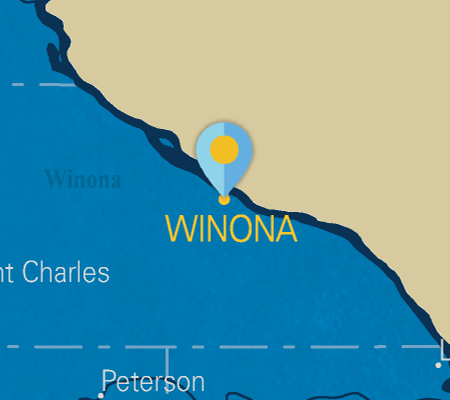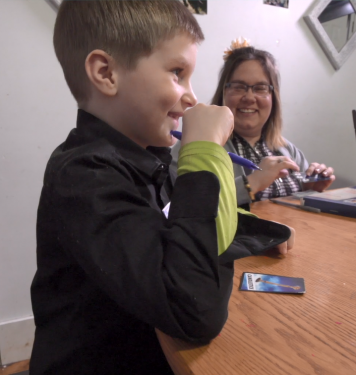
Connecting people to community resources for food, clothing, housing and employment
Winona Community HUB or “The HUB” is an evidence-based model of community care coordination that focuses on addressing social determinant of health (SDOH) risk factors in the Winona-area population.

The HUB addresses the complex needs of families experiencing food and financial insecurity to ensure that they have the resources they need to achieve the best health outcomes possible.
It’s governed by the Winona Wellbeing Collaborative, a collection of public, private, non-profit and community partners committed to improving the lives of Winona area residents.
“The HUB can help with everything from food and clothing to shelter to employment,” says Deb McClellan, Community Wellbeing Manager at Live Well Winona, the home of the Winona Community HUB. “Whatever that family needs, the HUB can help.”
The HUB uses the Pathways Community HUB model to find, treat and measure its impact on families referred for services. Referral partners first identify at-risk individuals or families and give them a comprehensive assessment of their health, social and behavioral health risk factors. If they determine risk factors, such as food or housing insecurity, exist, they refer that family to the HUB.
Next, each identified risk factor is assigned to a specific partner in the HUB, ensuring that a person or family’s needs are addressed with a best practice intervention. Providing a family with food, clothing, temporary or permanent housing, enrollment in school for school-aged children and other things are considered treatment elements.
Completion of each pathway confirms that risk factors have been successfully addressed. Marked improvement in chronic disease, reduction in emergency department visits, stable housing and employment are all considered measurements of progress.
In the HUB model, there are 20 different pathways that include basic needs such as food and clothing, to more complex needs like referrals to assistance in behavioral health, family planning, health insurance, medical assistance, energy services and social services.
“Winona is looking outside of what we would consider our traditional healthcare system, and bringing in all of those other factors that impact health, that we know are going to make huge impacts on not only individual health but community health as a whole,” says Dr. Mark Steffen, Vice President and Chief Medical Officer at Blue Cross and Blue Shield of Minnesota.
It starts with a community connector
The referral process begins with a staffer known as a “community connector”. That person visits a family’s home, determines the various needs and begins to tackle each need by working with community collaborators, such as food shelves, charitable organizations and other service providers that have agreed to participate in the HUB.
“The one thing that’s unique with our HUB is that we take a whole-family approach,” McClellan says. “If one person in the household is identified as being food insecure, we’ll treat the whole household as one unit. If mom or dad are food insecure, chances are the rest of the people in the family are, too.”
“At Winona County, we have two workers that are called parent support outreach workers. They work very closely with the HUB and do a lot of resource and referral for families,” says Karen Sanness, Winona County Health and Human Services Director. “We have specific criteria that the families have to meet with high risk indicators, such as housing or mental health or substance abuse- those types of issues which all fall under the social determinants of health.”
Winona County and Winona Area Public Schools are two of the biggest referral systems to the HUB.
“Within Winona Area Public Schools, we have social workers, counselors, classroom teachers and home visitors. When they are working with a family, the primary goal is to meet the educational needs of the family,” says Ann Riebel, Community Education Director for Winona Area Public Schools. “However, we know that families’ basic needs have to be met before they can focus on education.”
Recognizing innovation in community health
The work, and its many accomplishments to date, have earned the HUB a Blue Cross and Blue Shield of Minnesota Trailblazer award, which recognizes innovation in healthcare.
“I think what we’ve seen is that we can’t take a ‘one size fits all’ approach to healthcare, nor can we do that when it comes to community health,” Dr. Steffen says. “We need to look at those populations that have the most need and make sure we’re designing innovative solutions to address those needs.”
“This prevention/early intervention model is where I would love to see our community invest its resources and time to be able to keep people out of those deeper end services,” Sanness says. “It’s going to be less expensive, it’s better for our families and it’s less traumatic for the kids within our community.”
Working towards long-term changes
As with any community health initiative, the HUB has three goals in place. First, it works to ensure the complex needs of Winona families experiencing food insecurity are systematically identified, assessed and treated through evidence-based interventions to improve their outcomes. Second, it works to ensure seamless, effective and unique care is provided by service agencies. Third, it works to improve financial and health security for Winona families in need.
“We don’t want a quick fix here,” McClellan says. “What we really want is a system change. We want to be able to provide this family with all the resources they need to thrive as they go forward.”
“I think the real unique aspect of Winona is the amount of community collaboration,” Dr. Steffen says. “This isn’t just a single individual or group trying to drive an initiative, but rather, the entire system – both public health and private health care – as well as all of the nonprofit community partners who are banding together to improve the health of the entire community.”
